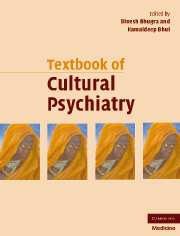Book contents
- Frontmatter
- Contents
- Contributors
- Foreword
- Preface
- Part I Theoretical background
- Part II Culture and mental health
- Part III Culture and mental disorders
- Part IV Theoretical aspects of management
- Part V Management with special groups
- 35 Intellectual disabilities across cultures
- 36 Child psychiatry across cultures
- 37 Management of sexual dysfunction across cultures
- 38 Refugees and mental health
- 39 Working with elderly persons across cultures
- 40 Working in liaison psychiatry
- Part VI Cultural research and training
- Cultural psychiatry: the past and the future
- Index
- References
36 - Child psychiatry across cultures
from Part V - Management with special groups
Published online by Cambridge University Press: 11 August 2009
- Frontmatter
- Contents
- Contributors
- Foreword
- Preface
- Part I Theoretical background
- Part II Culture and mental health
- Part III Culture and mental disorders
- Part IV Theoretical aspects of management
- Part V Management with special groups
- 35 Intellectual disabilities across cultures
- 36 Child psychiatry across cultures
- 37 Management of sexual dysfunction across cultures
- 38 Refugees and mental health
- 39 Working with elderly persons across cultures
- 40 Working in liaison psychiatry
- Part VI Cultural research and training
- Cultural psychiatry: the past and the future
- Index
- References
Summary
EDITORS' INTRODUCTION
The practice of child psychiatry is influenced by cultural norms and processes, as are other specialties within psychiatry. The needs of children from different cultures vary and yet within each culture there are individual variations. The earlier chapter by Dogra and her colleagues set the scene in clinical matters related to child psychiatry across cultures. This chapter by Karnik and colleagues provides an overview on management. The childhood behaviours occur in the context of families and cultures and balancing respect for variation and the need for universality is a key challenge.
Karnik et al. point out that good clinical practice in the West would involve valuing the child's perspective and ensuring their views were heard and accommodated, but how far this would work in other cultures is debatable. Cultural values must be taken into account when planning any intervention and more so in the case of instituting pharmacotherapy. Using attachment theory as an example, they suggest that addressing the child's attachment may take different forms depending upon the context. Children's social networks will differ across cultures and the role of peers is significant in the development of a child's self-esteem and identity. The reduction of stigma is also important and particular attention must be paid to vulnerable and at risk children.
The management of children in cross-cultural context
Introduction
Practising child psychiatry across cultures is one of the most challenging and yet potentially gratifying areas of professional practice.
- Type
- Chapter
- Information
- Textbook of Cultural Psychiatry , pp. 471 - 483Publisher: Cambridge University PressPrint publication year: 2007
References
- 3
- Cited by



